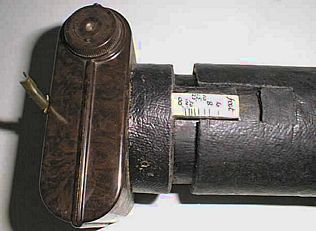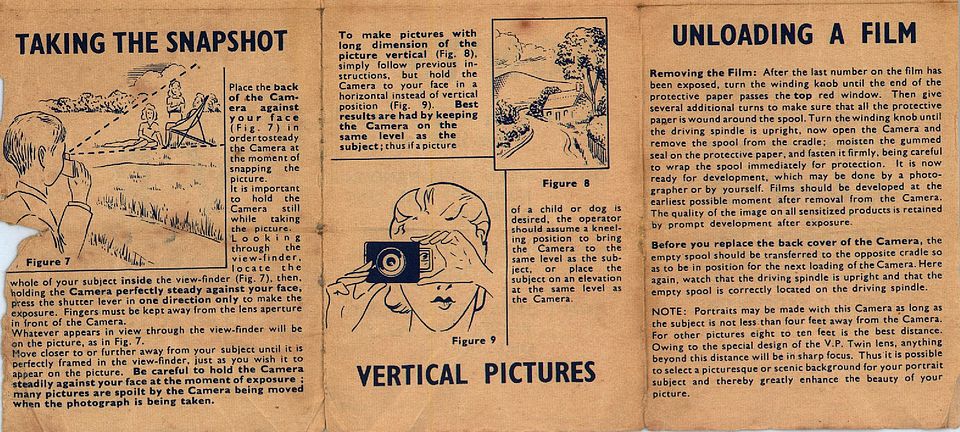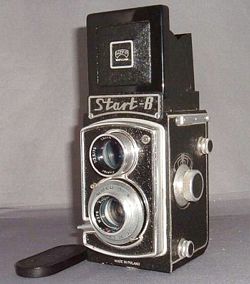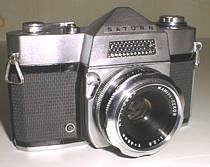| My First Cameras & Darkroom |
|
|
|||
| The VP Twin | |||
|
Mine cost 7/6 in pre-decimalisation 1957, which is 37.5p in decimal pence; perhaps £10 in 2024 value. The VP Twin was difficult to use successfully, especially by an inexperienced 11 year old. Its open frame viewfinder could lead to catastrophic framing errors and the shutter release was awkward, so that camera shake was commonplace. I still have prints supplied by Gratispool from a holiday at Blackpool in 1957 which amply demonstrate the framing and camera shake errors I suffered. The history of the VP Twin, manufactured by E.Elliott Ltd based in the West Midlands, has been excellently researched by David Gardner, resulting in a comprehensive article in the magazine Photographica World, issue No.108, 2004/2, of the Photographic Collectors Club of Great Britain (PCCGB). Quoting from David Gardner's
article: "Although produced mainly in black, the VP Twin camera was given a facelift (quite literally) in the early 1950s by fitting a metal plate to the front with the BOLCo name and the 'L-Yacht' trademark ('L' in a Yacht = Elliott) proudly displayed". The chief optical engineer at BOLCo was Frederick Archenhold who, in a 1950s collaboration, designed and led the manufacture of lens elements for Corfield's Periflex camera's 50mm f/3.5 Lumar (1953), 50mm f/3.5 Lumar-X (1955) and 100mm f/4 Lumar (1957) and 150mm Lumar lenses. (More about Fred Archenhold appears below the VP Twin instruction pages). |
|||
|
Correspondence within my family, dating to May 1935, talks about a camera having just appeared for sale in the high street store Woolworth's, taking 16 pictures on a roll of film normally sized for taking 8 pictures (so presumably 127 size). This reference to the first appearance of what is almost certainly the VP Twin agrees well with the 1936 date found by David Gardner in his research. Woolworth's sold this camera until the early 1960's (Ref: an email from David Burrin, July 2018, who believes his was purchased from Woolworth's in 1963). Thereafter, competition from other low cost, but superior cameras, may have forced it out of production. But by then some half a million had been sold by Woolworth's alone. A detailed chronology of the various design changes that took place during its circa 30years of manufacture is not available. It seems likely the VP Twin first appeared in black with its lens installed (invisibly) behind the single speed, self-setting, shutter. Subsequent design changes were introduced, presumably after its initial popularity had been proven. Appearance changes included bringing the lens forward, in front of the shutter, and also manufacturing the camera in a range of moulded Bakelite colours. David Gardner identifies ".....a range of colours most of which - brown, maroon, green and blue - were quite dull, in contrast to a wonderful bright blue version which must have been the 'vanity' model." There were also variations in the design of the boxes that the camera came in, and the small carrying cases that were available. Opening the camera to load a film was tricky as there was no built-in body separation 'latch', as on most cameras. The body halves relied upon being held together via an 'interference fit', which also provided the necessary light trapping. Hence the two halves had to literally be forced apart, an action that was especially awkward on the earliest version, see below, left. |
|||
 |
 |
||
|
Below to the left is shown the early design, from around 1935, with the lens behind the shutter. The uninitiated might presume there was no lens in the camera (the image below has been lightened to enable viewing into the hole where the lens might be expected). This sort of 'lens behind the shutter' design is not novel - e.g. Kodak used it on many of its early 'simple' cameras. Some time later, Elliott brought the lens in front of the shutter, as shown by the middle picture, below. The reason for the change is unknown but may have been to improve the camera's cosmetic appearance. The example shown is the brown version amongst the various colours described by David Gardner. Exploring the internet for examples of this 'middle' design, it seems that most (surviving) examples are brown or other colours. Black versions seemingly exist but seem scarcer. 'Seemingly' is used because the precise colour of some dark coloured versions is difficult to distinguish from black in on-line advertisements. For reasons explained below (see picture of three boxes), the 2nd version seems to have been available before 1940. The final design, from around 1950, has a much more modern appearance with its nameplate and coated BolCo lens, as shown in the right hand example. Note the Elliott ('L' in a Yacht) trademark. This version seems to exist in profusion but the author has been unable to find any coloured examples. |
|||
 |
|
|
|
The wind-on knob has a satisfying clicking sound ratchet action that prevents the knob being turned except in the correct direction. Numbers on the backing paper of the film are first aligned in the lower red window on the back of the camera and, after taking a picture, the knob is turned until the same number appears in the upper red window. By that means, 16 exposures are obtained from the nominal 8 exposure film numbering. Although most all VP Twins have a body coloured ribbed edge knob, as in the left picture below, two alternatives have been found. The centre picture shows the standard knob but in pure white! David Gardner's Photographic World article, in Spring 2004, shows a similar VP Twin at the top right of the opening page, so this arrangement is not unique. The third example, a winding key, may be home made. |
||
 |
|
|
|
Another variation, this one clearly a 'do-it'yourself' addition from someone trying to overcome the deficiency of the open frame viewfinder. The folding optical viewfinder is cleverly clipped around the lens, leaving the shutter lever free to move as normal. |
|
|
|
This variation is someone's attempt to adapt the VP Twin body to take a long focus lens, possibly 135mm. The shutter mechanism and lens of the VP Twin must have been removed and the new lens would have been mounted at the end of the tube, complete with its own interlens shutter. An equivalent viewfinder frame has been appropriately added to the front of the lens tube with a 'rear-sight' on the body. The slide action focussing has been scaled from infinity to 6 feet. The normal fixed focus BolCo lens fitted to the VP Twin is reported to have a f12.5 aperture. Measurement suggests its focal length is 45-50mm, though may have been nearer to 40mm when the lens was fitted behind the shutter in the early versions of the camera. These focal lengths are not unreasonable for the size of negative. |
 |
 |
| The images to the right display two camera case designs. |
 |
 |
|
Another case, appearing to be plain black, but the colours of the camera and its case are uncertain as the eBayer advertising this VP Twin (August 2024) described the camera as green. Notice that this is the middle design of VP Twin i.e. with the lens in front of the shutter. Other case designs than the three shown here may exist. |
|
|
|
This image shows a variety of boxes that once housed VP Twins. Picture courtesy of Charlie Kamerman; http://www.KodakCollector.com. The illustration on the box at the left hand end suggests it is from the 1950s. The box to the right hand end
is interesting because of the note at the bottom which seemingly
identifies the box as one of the the earliest designs from around
1935. It reads: The 6d price limit in the 1930s seemingly ended around the start of WW2, as prices rocketed and cheap goods became hard to find. |
 |
|
|
To the right is a 2nd version VP Twin being sold on eBay in August 2024, together with its box. Notice that the box is the same as the right hand one in the picture above, and again references a shortened length 127 film being available from Woolworth's for 6d. Notice that the VP twin is a brown coloured, 2nd version design, i.e. formed from coloured Bakelite and with a front mounted lens. This suggests, therefore, that the redesign of the original to having a coin operated back opening arrangement, a front mounted lens and availability of coloured versions, all took place in the five years before the 1935 camera's first introduction and the September 1939 start of WW2. |
|
|
|
|
||
    |
||
| An interesting
additional piece of BOLCo information appeared as 'Letter of
the Week' in Amateur Photographer magazine for 14th September
2013. It was written by Antoni Kowal. He was involved in the
final days of Voigtländer as a manufacturer of cameras and lenses
in 1972/73. Antoni initiated the purchase of the contents of
the Voigtländer lens production plant while he was working
for BOLCo in Walsall. He says: "...BOLCo was being run by Fred Archenhold, son of the founder of the Archenhold Observatory in Berlin, a Jewish refugee lucky to escape just before persecution turned really nasty (even for illustrious scientists such as Archenhold Snr.). Fred was the saviour of BOLCo (owned by the Elliott Engineering Co) and kept the business going throughout the 1970s." "I informed Fred of the announced cessation of production by Voigtländer and arranged for him and myself to travel to Braunschweig in 1973. We agreed that BOLCo would buy the contents of the factory, with emphasis on the lens side (grinding, polishing, lapping and coating equipment, and so on). The equipment was duly delivered to BOLCo by Kuehne and Nagel and employed in production at the Walsall plant. Thus Voigtländer's lens production plant became part of a British business." |
||
| The Year 1957, apart from the VP Twin | ||
|
By coincidence, 1957 also saw the appearance of the Ilford Sportsman camera range. The first Sportsman cost over £13, about the same as an unskilled working man's weekly wage. It was far too expensive for my shallow pockets at the time. In 2024 monetary value, the original Sportsman cost £350 !
I was always impressed by these adverts, so much so that I visited the 127 New Bond Street premises of Wallace Heaton Ltd while in London on a 6th Form school trip around 1962. All I could afford was a single half-plate developing dish, but I was proud of making a purchase in such a prestigious shop. Wallace Heaton was the premier photographic retailer in London. At that time, the Wallace Heaton chain was being run by Wallace Evans' son John Wallace Heaton, born 5th September 1907. Alongside is a photograph of Wallace Evans Heaton, printed in Number 4 of Wallace Heaton's "PHOTO GRAPHIC and PHOTO NEWS" quarterly magazine (price 3d = 1.25p) that commenced publication in Spring 1947. Wallace Evans is holding David John Wallace Heaton, born 21st February 1947, 2nd son of John Wallace Heaton. The text reads "In a world of shortages....we have made sure of a continuous line of Wallace Heatons for three generations...so far. Proof: The photograph shows Wallace Heaton senior with Wallace Heaton junior's youngest son". The "shortages" referred to in the text is a reference to the extreme austerity in post-war Britain (at that time). Alan Owens worked at Wallace Heaton in New Bond Street from July 1957 to April 1962 in the enlarger dept on the first floor. He tells me "I sold my Hornby Dublo (electric train set) to finance my introduction to photography (a friend had a Trix-Twin). I joined Wallace Heaton from leaving school at age 16 and after 6 weeks in the stock room entered the enlarger dept. My first manager was Dave Milne, but he left to become sales representative for Photax Ltd. Dave Milne's successor was Val Bidlake followed by Michael Hazelman and then Jim Fry, who was manager when I left. I was a self-employed photographer from 1966 to 2006, as Alan M Owens, L.B.I.P.P., L.M.P.A., L.R.P.S. but have now retired, and reacquainted myself with my interest in Hornby. My first camera was a Ross Ensign Fulvue, taking 12 on 120 roll film". |
||
|
In the logo alongside, from the December 1947 issue of PhotoGraphic and Photo News, the text reads "By Appointment to His Majesty The King, Suppliers of Photographic Equipment". In 1947 this text referred to King George VI. |
||
|
Other 1957 happenings: While indulging in the nostalgia of the 1950s and 1960s, take a look at John Chenery's site, especially the page where he shows pictures taken on Ilford film at Butlins Clacton in 1964, when he was a lad of five. In 1964 Ilford had a 50% interest in Butlins Photographic Services Ltd. which operated photographic services at seven holiday camps, two hotels and a beach outlet. |
||
| After the VP Twin | ||
|
I sold my VP Twin, after about 12 months ownership, to a cousin for 5/- (25p) and purchased a Coronet Flashmaster (or similar 12 on 120 Coronet) by weekly payments via my mother's Burlington home shopping catalogue. According to the 1956 BJPA, it cost £1.11s.3d (£1.56p). My success rate was immediately transformed. The picture shows the Flashmaster equipped with its CoroFlash flashgun, which has a proprietary 2-pin fitting. The 1957 price was 13s.1d (65p). From David Gardner's research it seems that Elliotts may have produced Bakelite bodies for Coronet cameras, as the two companies are known to have collaborated in the 1930s when their factories were in close proximity. |
 |
|
 |
It wasn't long before I wanted to try developing my films and making my own prints. So, around 1959, I purchased a Johnsons of Hendon Home Photography outfit, containing the sort of simple equipment shown alongside. To see an Amateur Photographer magazine advertisement for an even simpler Johnson 'Print -a-Snap' pack, in September 1955, click here. To download copies of the leaflet shown left (May 1961), click here, and for the Print-a Snap leaflet, click here. There is a black Bakelite contact printing frame (RHS, back of picture) to produce prints from negatives up to 2½" x 3½" (as 8 on 120 or 620 roll film), a set of See-Thru red masks in order to produce white borders around prints down to 35mm, two ¼ plate developing dishes (black & orange) and two print forceps (black & orange). It also contained a Johnsons instruction booklet: 'How to start ~ Printing your own Photographs', some contact paper and packets of developer and fixer. Johnsons first introduced their Bakelite contact frame at the end of 1947 to replace a wooden version; wood was prone to warping. An advert in Amateur Photographer (AP) for December 1956 shows this Junior Kit retailing at 13s/6d (66p). The same advert shows Outfits of increasing complexity, rising to the No 4 at £5.12s.6d (£5.63p) |
|
| My kit contained two additional items; a battery powered dark red safelight, giving sufficient light to enable orthochromatic roll films to be developed by see-sawing them through developer and fixer in open trays, plus a copy of the 4th Edition of Johnsons 'Home Photography'. It was that booklet which inspired my growing interest and made me long to own an enlarger. My regular Wednesday copy of Amateur Photographer, full of tantalising advertisements, was a regular 'read'. | ||
|
Enlargers were too expensive for me and I looked at possible sources of 'bits & pieces' to enable me to build my own. Everything was more expensive in those days relative to most ordinary working folk's purchasing power (1960) and it wasn't unusual for people to try to build equipment. I enjoyed trying to make things, but my skills were relatively crude and I had no metal working facilities. Hence, I bought the cheapest enlarger on the market, the Agilux, Agiscope. A full page Agilux Ltd advert in AP, 24th October 1956, gives a retail price of £7.5s (£7.25p) but by May 1962 it was being sold at £6.5s (£6.25p). It was complete with a simple lens, which would otherwise have been yet another on-cost. The Agiscope was made by Agilux,
Croydon, and was sold through various of the larger photographic
retailers. I think I purchased mine by post from Sands Hunter.
It was a plastic bodied enlarger with a 15" x 13" wooden
baseboard and 22" inclined metal column. Light diffusion
was by a sheet of flashed opal glass (no condenser lenses) which
also held the negative flat within the carrier. It came with
masks to enable enlargements from 35mm to 2½" x 3½"
negatives. After struggling to focus my Agiscope using various special focussing negatives, I saw a Harringay Photographic Supplies Ltd advert in AP, offering enlarging lenses at the very low price of £1.9s (£1.45p). These lenses, available in either 3½" or 4½" focal length, had apertures f6.3 and f11 via a sliding plate with two holes and 'special barium glass component'. I reasoned that if I could substitute one of these lenses (3½" probably) for the lens in my Agiscope, I would be able to focus at f6.3, having a brighter image, and stop down to f11 for the exposure, enjoying some focussing latitude. |
 |
|
 |
Harringay eventually became
part of the Phototec Group I proceeded to cut away the Agilux lens from within its helical focussing mount (the red plastic knurled item visible in the ebay picture to the left) and substitute the lens from Harringay. No doubt what I did was constructionally very crude, but I managed to fix the new lens in position and align it such that I then used the new set up for several more years. |
|
|
My first 'serious' camera was a relatively low cost, and simple design, 12-on-120 film twin lens reflex made in Poland, named the 'Start B'. It was imported from June 1961 by Apparatus & Instrument Co.Ltd (A.I.C.O. Ltd) of Aico House, 36 Grove Road, Hounslow, Middlesex. It had a matched pair of 75mm f3.5 Euktar lenses, a shutter speeded 1/10th, 1/25th, 1/50th, 1/100th, 1/250th & B, and the usual TLR collapsible hood and built in focussing magnifier above a ground glass screen. It cost £12.16s.4d plus £1.19s.9d for the ever ready case. I'd sold my Trix-Twin electric train set (rarely played with any more) to fund purchase of the Start B, but was never really happy with the camera. The side-mounted focussing knob seemed accurately enough set to give good focus on the viewing screen and on the negative, but it moved noticeably past infinity. These days I would simply take the item back to the retailer for repair or replacement, but I was young, naive and mechanically inquisitive enough to fiddle on, trying to reset the focussing myself and ended up damaging the camera to the point I lost interest in it. |
|||
 |
 |
 |
 |
|
By the summer of 1964 I was earning a small wage, sufficient to enable me to purchase (by weekly installments) a fixed lens single lens reflex (slr) called the Mamiya 'Saturn' (originally sold by Mamiya as the 'Family' in the US and the 'Penta' in the UK) from Dixons in Union St; Birmingham. The 'Saturn' was also sold by Bennetts in New St. Birmingham, as the 'Korvette'. The Mamiya 'Family' (aka 'Penta', 'Saturn' & 'Korvette') and most all Mamiya 35mm cameras, are shown on Ron Herron's excellent site. Later I 'upgraded' to a Russian Zenith 3M slr with an interchangeable f2 Helios lens (see below, left), augmented by a Hanimex 180mm f3.5 telephoto. To download the instruction booklet for a 1974 Zenith E (similar to the 3M but with a built-in selenium exposure meter) click here. The booklet is available courtesy of Tasker Dunham. See his blog "Tasker Dunham's Yorkshire Memories". |
 |
|
 |
By 1969, fed up of carrying around the heavy Zenith with two lenses and an exposure meter, I simplified my picture taking by trading in the Zenith for a Minolta ALF (see right) and started taking just 35mm colour slides. In mid-1970 I left home to pursue my career. I took my AL-F with me and gave up darkroom work. 40+ years later I still have the AL-F, tucked away in its original box and packaging. Unfortunately, I lost the 'slip-on' lens cap in Washington DC while on a business trip to the USA in 1982. |
 |
|
In 1981 I purchased a Durst M302 35mm enlarger with colour head from Jessops (Hinckley Rd, Leicester, in those days) and tried my hand at colour printing negatives from my Canon AE1 slr. I purchased a f2.8 El-Nikkor enlarging lens and gradually became proficient at subtractive colour printing. However, home colour printing was a time-consuming and error prone process that, on many evenings, kept me from spending time with my family. It was a way to exercise control over the finished print on those rare occasions when a 'shot' was a particularly good one, but could never replace commercial processing for speed, cost and convenience. In the early 1990s, when I stopped colour printing, no one knew the image quality that would become possible by digital colour inkjet printing. Now (2007), inkjet print quality is amazingly high, and is the only sensible route for the amateur. I still use my enlarger and
el-Nikkor occasionally, though now only for Multigrade black
& white printing. |
||
| Read about my
Colour Printing experiences: |
||
|
|
||
 Another
1957 happening, on a less happy note, was the death on January
18th of a famous name in photographic equipment marketing.
Another
1957 happening, on a less happy note, was the death on January
18th of a famous name in photographic equipment marketing.  The
Wallace Heaton chain was eventually purchased by Dixons in 1972,
by which time there were
The
Wallace Heaton chain was eventually purchased by Dixons in 1972,
by which time there were 